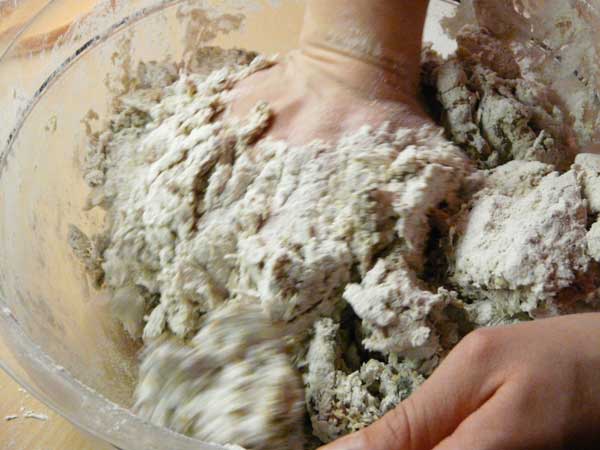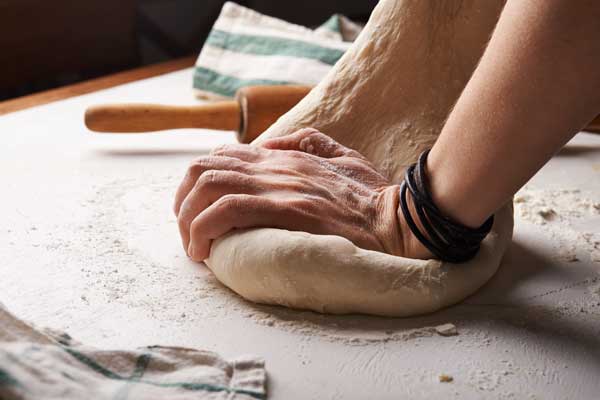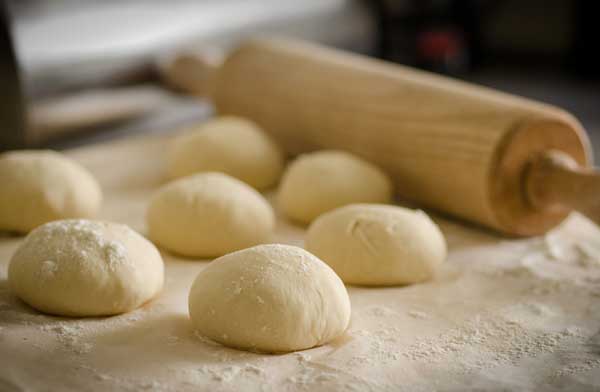Expert tips for home breadmaking.
Written by Jennifer Rachel Baumer
Homemade bread is a simple, wonderful, economical luxury. Breadmaking can feel intimidating, but some of the best loaves are made with nothing more than flour, yeast, water, and salt.
Bread is more forgiving of altitude and desert dryness than pastries or cakes, but both factor into baking the perfect loaf. So do the quality of ingredients and the handling of the dough. The following tips from Reno bread experts are meant for bread made by hand, not by bread machine.
Quality counts
First things first. Bread is mostly made up of flour, so buy the best.
“All-purpose flour is not all right,” says Nathalie Atwell, owner of House of Bread in Reno.
Use a high-quality, high-protein bread flour sourced from such companies as King Arthur Flour or Bob’s Red Mill. Use stone-ground, chemical-free, whole-wheat flour. These tend to be more easily digestible. Italian “00” flours typically used in pasta making also are good options for those with gluten sensitivities (though not safe for those with celiac disease).
Hands off
Yeast doughs usually require kneading, but don’t go overboard.

“Don’t touch,” Atwell says. “People keep working the dough because they want to make it better. But the more you touch the dough, the more strands the gluten creates.”
That’s what it’s supposed to do, but when it’s overdone, bread becomes too firm. It’s like baking cookies, Atwell says: When you think they need two more minutes, they’re done. Take the loaf out before it becomes tough.
Don’t overthink it, either
“Some of the best breads don’t require constant attention. They require minimal manipulation. They’re longer-fermentation breads that don’t require as much work. There’s a time commitment, but not as much manual labor,” says Lara Ritchie, culinary director of Nothing To It! Culinary Center in Reno.
High-altitude adjustments
Nevada’s desert climate means dough needs more water and less flour. According to Atwell, above 3,500 feet, reduce yeast by 10 percent and increase water by 10 percent. And the higher the altitude, the shorter the rising time.
“There’s less atmospheric pressure. Yeast has a little more freedom to run wild without the dampening effect,” Ritchie says.
Yeast feeds off sugar and responds to heat (and time) to rise. The warmer the surroundings and the less pressure on the yeast, the faster the rise. To slow a rise (to develop flavor), let the dough rise in a cool area (or overnight in the refrigerator). To speed up the rise, use a proofing box, which combines heat and steam to create a hot environment and force a faster rise. Too fast a rise can result in unpleasant, fluffy textures.
Humidity factors in, too. The drier the day, the more likely it is that the dough will use all the liquid listed in the ingredients but not all the flour. Dough should feel elastic and bouncy, just tacky enough to barely stick to the fingers.
“Knead until it feels right. Maybe don’t take out the day’s aggression on the bread,” Ritchie says.

Write it down
“Any time you start a bread or dessert, have a journal nearby and write it up, especially with bread,” says Katie Bennett, executive pastry chef at Liberty Food & Wine Exchange in Reno.
Bennett records whether the day was dry or wet and whether it was summer or winter because humidity and temperature affect artisan bread. If the bread doesn’t turn out quite right, she notes the details and tweaks the recipe accordingly the next time.
Gluten free?
Sure, it’s possible, and the experts largely recommend King Arthur-brand, gluten-free flour mixes. The dough might feel a little wetter, but it just takes getting used to. Also, try gluten-free teff or sorghum flour from Desert Oasis Teff & Grain in Fallon (available at the Great Basin Community Food Co-op in Reno or online).
Gluten is the protein in wheat and other grains that gives bread its elasticity and helps it rise. It may not be the culprit causing all the gluten intolerance symptoms for most people. Rather, vital yeast, a manmade additive that promotes longer shelf life, may be to blame.
Those breadmakers not avoiding gluten might want to experiment with high-gluten, high-protein flours.
“Make a batch of brioche with bread flour and another with all-purpose flour, and see which you like best,” Bennett says.
“Be fearless,” Ritchie says, pointing out that the world won’t end if the bread doesn’t work. “There’s going to be a lot you learn on the way, whether successful or not. That’s the joy of cooking.”
__________________
Jennifer Rachel Baumer is a freelance writer who has been baking bread since she was in high school and owns way too many breadmaking cookbooks. She believes practice makes perfect and in eating her mistakes.
RESOURCES
Desertoasisteff.com
Kingarthurflour.com
Bobsredmill.com
Nothing To It! Culinary Center
225 Crummer Lane, Reno
775-826-2628 • Nothingtoit.com
House of Bread
1185 California Ave., Reno
775-322-0773 • Reno.houseofbread.com
Liberty Food & Wine Exchange
100 N. Sierra St., Reno
775-336-1091 • Libertyfoodandwine.com
Sandwich Loaf
(courtesy of Jennifer Rachel Baumer, home baker in Reno. Makes 1 round loaf)
This is my favorite basic loaf, a quick-and-easy, never-fails bread that can be made in less than 4 hours, tastes great warm from the oven, and makes wonderful sandwiches.
4⅔ cups all-purpose or bread flour, divided
1½ teaspoons sea salt
1¾ cups warm water
1 packet yeast (or 2¼ teaspoons)
In a large bowl, mix together 3⅔ cups of the flour with the sea salt and yeast. Make a well in the middle of flour and add water, gradually stirring flour into well to make a sticky batter. Stir in just enough of the reserved flour to make a shaggy (lumpy yet well-mixed) dough.
Turn dough out onto floured work surface and knead gently for 4 to 5 minutes, using reserved flour to keep dough just barely sticky but not clinging to your fingers. Return dough to mixing bowl and cover with plastic wrap or tea towel. Let rise in a warm spot. At 4,000 feet and above, the dough should rise in about 1 hour.
Punch dough down to deflate, then turn it out onto floured work surface and gently knead it just enough to shape it into a round loaf. Don’t overwork dough or bread will become tough. Place loaf on a baking sheet lined with parchment paper, or a sheet that’s lightly greased or lightly sprinkled with cornmeal. Cover with tea towel or, for a slightly chewier crust, enclose it in a large, inflated plastic bag. Allow loaf to rise until doubled, about 1 hour.
When dough is almost finished rising, preheat oven to 425 degrees F.
Uncover loaf and slash the top several times with a sharp knife. Bake 35 minutes or until loaf is golden brown and sounds hollow when bottom is tapped.
Brioche
(courtesy of Katie Bennett, executive pastry chef, Liberty Food & Wine Exchange in Reno. Makes 1, 14-ounce loaf)
4 cups bread flour
⅓ cup all-purpose flour
3 tablespoons sugar
1 teaspoon salt
2 tablespoons room-temperature butter
1 cup room-temperature water
1½ teaspoons dry yeast
¼ cup milk
1 egg
In a mixer with a dough hook, mix together dry ingredients. Add butter and mix until pea-sized balls are formed.
Mix together water and sugar. Add yeast and stir to dissolve. It is important not to let this sit as the yeast will die. Add milk and egg, then stir so all ingredients are combined. Add all your wet ingredients to dry ingredients. Mix until dough comes together into a smooth ball with no dry spots.
Gently knead dough on a lightly floured work surface and form into a ball. Spray inside of a large bowl with nonstick spray and place dough inside. Tear off a sheet of plastic wrap, spray the plastic as well, then cover the dough. Proof until dough has doubled in size.
Once dough has proofed, remove to a lightly floured work surface. Shape the dough.
Combine by bringing the dough to center and rolling it into a ball. Leave as a loaf, or divide dough into 4 equal-sized balls for hamburger buns; 7, 2-ounce balls for slider buns; or 14, 1-ounce balls for dinner rolls. Place on greased sheet pan and brush tops with egg wash, then top with pepper.
Preheat oven to 380 degrees F. Allow dough to proof until loaf or bun is desired size. Bake for 11 minutes.
Pecan Honey Whole Wheat Loaf
(courtesy of Lara Ritchie, culinary director, Nothing To It! Culinary Center in Reno. Makes 1 loaf)
1½ teaspoons SAF yeast
1½ cups water (at about 105 degrees F)
3 tablespoons olive oil
5 tablespoons honey
3½ cups whole-wheat flour
½ cup toasted pecans, chopped
1½ teaspoons kosher salt
Preheat oven to 350 degrees F. This dough can be mixed by hand or with an electric mixer. If doing it by hand, use a large bowl and a wooden spoon to mix; if using an electric mixer, use paddle attachment.
Combine ingredients and stir, by hand or in mixer, until dough looks shaggy. Then allow dough to rest for 20 minutes (giving flour a chance to absorb liquids).
Generously dust your work surface with flour and turn dough out of bowl. Knead it for about 10 minutes, until it’s smooth and supple. The dough will seem very wet and slack at first; just keep kneading, and eventually it’ll come together. You want this dough to be a bit tacky, but you may need to use more flour as this is a pretty wet dough.
Allow dough to rise in a greased, covered bowl for 1 hour. Dust work surface with flour and turn dough out of the bowl again. First, flatten it with your hands, then shape it into a rectangle that’s 1 inch wider than the pan it will cook in. Then roll dough into a log and place it in a lightly greased 8.5-by-4.5-inch bread pan. Cover pan with a towel or loosely cover with greased plastic wrap and allow it to rise about 1 hour, until it has risen about 2 inches over rim of pan.
Bake bread for 45 minutes, tenting it lightly with aluminum foil for the final 20 minutes of baking.


